3/8/2014. Frost remains an issue. I'm getting frustrated with this. It occured to me (at last) that the problem may be simple. Maybe I just have bad desiccant. If I remember awright, I cheaped out the last time by buying tons of the right size PillowPaks from an eBay supplier. Maybe it was junk.
This evening, I'm baking the original SBIG desiccant cartridge according to the OEM's recipe for recharging it (heat oven to 350°F, throw it in there, wait 4 hours). This used to work well until I started using Particle Wave Technology's replaceable desiccant system which also worked well at first. So what's changed? Maybe the desiccant suppled when the PWT was new has become saturated. Perhaps the new packs were ineffective to begin with. Or maybe they, too, have become saturated. Recharging the original desiccant and buying fresh packs from a reliable supplier are cheap, simple fixes. If neither works, something more serious is wrong, but let's try easy first. The oven is on, and I've ordered fresh molecular sieve packs from Farpoint sold by Opt.
Tonight I'm imaging at -15°C to avoid frost which appears around -20°C . I used to use -40° from time to time and -30°C routinely. I'm making fresh flats and fresh darks in preparation for a night of 150s exposures. At this relatively balmy chip temperature, I prefer shorter exposures. There'll be less noise in each and twice as many frames to average. And I can make twice as many 150s darks as 300s darks before turning to tonight's targets. With the bright moonlight out there, 150s is probably a reasonable exposure anyway.
Imaging NGC 2805. I thought I would just use this page to keep track of one promising image: the field of NGC 2805 and the galaxies with which it is interacting. I found this field in Guide 9.0 while casting about for something to shoot in the early springtime sky. Here's the map:

The big white rectangle is the area of the imaging chip; the smaller one shows the field seen by the guide chip, I wasn't sure what I'd find, but it turns out that quite a lot is happening eigthy million light-years away in this corner of Ursa Major. In the CCD's first highly stretched 10 second "find deep sky object" frames, the big spiral appeared disjointed, its outer arms connected by something like spokes to its inner structure. It reminded me of the "Cartwheel" galaxy Hubble imaged some years back. The variety of shapes in the field added intrigue. I looked for but didn't find many photos of this area online. That could mean it will turn out to be boring in deeper images, or it could be that it hasn't been mined out by my fellow deep sky enthusiasts. (Last time I went looking for an obscure but fascinating galaxy of my own, I spent several nights on NGC 3718, only to have a photo of it by Martin Pugh turn up and win an international competition. Use the search button up top to find my weak sister efforts.)
I focussed carefully on a bright star. Here's Capella through a Bahtinov focusing mask:
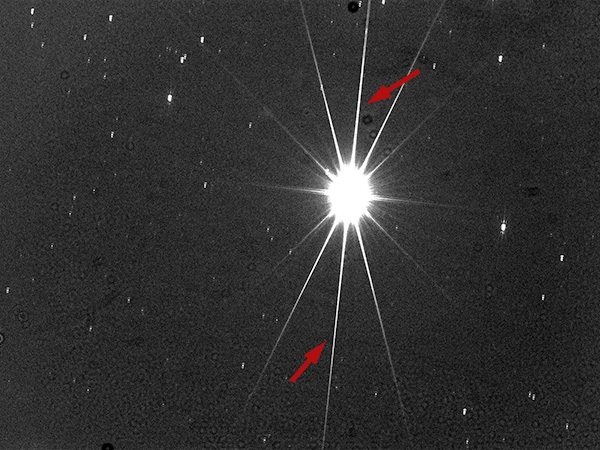
The beauty of the Bahtinov mask is that the marked, nearly vertical diffraction spike moves
left and right as the camera moves through the point of best focus. When it's exactly
centered, as shown here, you've nailed it. Better, as you move toward the best point, you
can readily tell whether you're not quite there or if you've moved just beyond it.
We begin: the nearest ClearSkyClock (Colby) predicts deteriorating conditions through the first part of the night. Improving skies much later will come after the field moves too low to keep shooting. So get on it. I started collecting 150s luminance frames and monitored transparency by watching the peak brightness of the guidestar (~6000 ecu in 15s integrations). Seeing is not as good as last night (~3.0 arcsecond PSFs at best), but guiding is excellent. As promised, transparency suffered as the night went on. With 55 luminance frames on the disk, I switched over to RGB frames just before midnight, figuring I had as much data for the L channel as I was going to get and that I might as well preview some color for the stars. They're pretty much useless and will surely be obsoleted on the next clear, frost-free night.
Here's a stack of the best third of the luminance frames (FWHM < 3"):
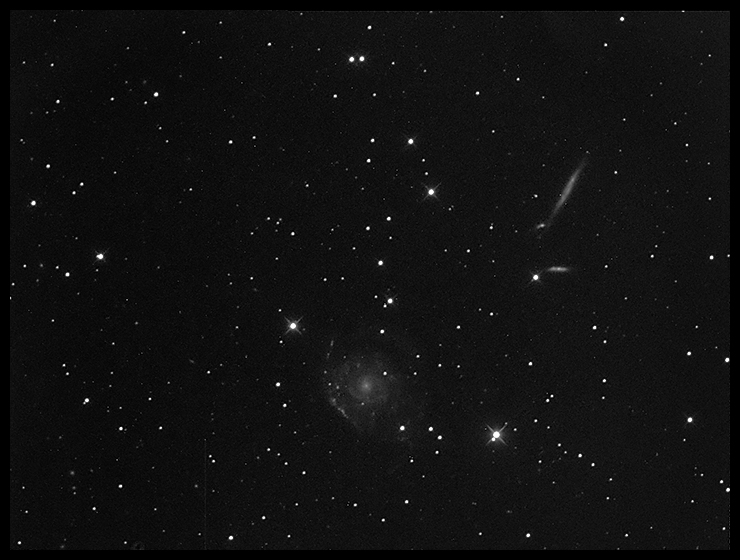
NGC 2805 and friends
19x150s L (47m 30s total)
This is practically all the useful data from the first night; remaining L frames add nothing of value. The big face-on galaxy is the disrupted spiral NGC 2805. As you can see, it's pretty dim. The outermost regions (look around the 1 to 3 o'clock position) are really dim. This field may be a hobby unto itself for a while. This is more of reality check than a good beginning: it's clear from this effort that the interesting stuff is within reach. I need clearer skies. A cooler -- electronically quieter -- chip would be good, too.
Around midnight, I pulled the SBIG desiccant cartridge from the oven, stashed it in a small airtight jar with another packet, and went to bed. In the morning, I'll install it in the camera and hope for good news tomorrow night.
3/9/2014. I served baked desiccant for breakfast. Swapping desiccant cartridges needed to be done quickly to keep moist air out of the CCD chamber. I put some bacon in the microwave to cook for three minutes, and by the time it was done, so was the swap. I put the camera back on the telescope and ran the camera's fan all day to move dry air through the cartridge and draw water vapor from the chamber. The first glance at -20°C looked pretty good, but the day was young. I cycled it several times between zero and minus 20 Celsiius. I held the chip just above freezing most of the day to give moisture every chance to migrate into the drying chamber. A couple of hours before dark, I lowered the chip temperature to what I hope is its operating temperature overnight and let the last of the frost, if any remains, sublimate.
Each of these four frames shows the state of the CCD at -20°C some hours after I installed the newly recharged OEM desiccant. As you can see, things were looking a little dicey right up till nightfall (shortly after the final frame). Also, if I thought that first frame looked "pretty good," then you can imagine how awful yesterday's state of frost looked.

Around nightfall, I took a series of new flats. Then 24, 300-second darks and 24, 150-second darks all at -20°C. By then, NGC 2805 was in the open sky and I got serious about piling up some eighty million year old light. I touched up the focus on Capella, slewed to the target field, found a guidestar, calibrated the guiding software, and... we're off.
The seeing is comparatively dreadful. At first I thought I was shooting through the last boughs of Bird Feeder Pine, but a visual check says not. I tried refocusing using PSF measurements, but got nothing for my trouble. I returned to Capella with the mask and re-zeroed focus. And back to the field. PSFs are running around 5 arc seconds! Tracking is good, but I can't get a sharp image for anything. I'll let it run and see what happens.
In the morning, I pulled 63 luminance frames and 18 color frames. The last several L frames were grotesquely blurred (dew). Maxim's quality tab let me select the best 47 luminance frames by taking only those with PSF's under 5 arc seconds. Summing them using the SD Mask option in MaximDL effectively reduced the PSFs to 3.8 - 3.9 arc seconds. Judicious deconvolution in Pixinsight made things better still. All in all, I'd rather start with good data. Here's the overnight returns in L:

NGC 2805
47x300s L (3h 55m)
which is better, but not yet the killer luminance layer I want. More data. Deeper, sharper! And better darks and flats. As usual with feeble targets, an inverted image reveals what's in there but is yet to be put on vivid display:
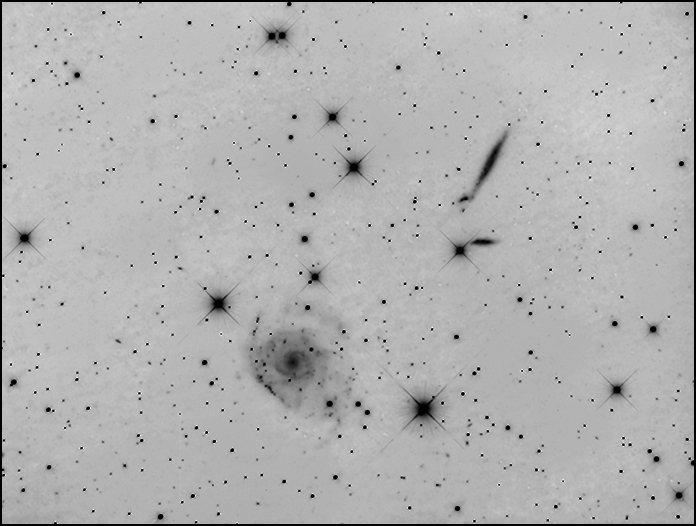
NGC 2805
47x300s L (3h 55m)
Given the poor seeing, I should probably have dedicated last night to collecting a large pile of color. But I really wanted a deep look, so I took mostly L data. Good color will go far toward highlighting in a positive image what is seen now only in the negative rendition.
This morning, I dropped the chip temperature to -30 and -40. Frost reappeared (no surprise) but did not spread from many, many donut-shaped shadows. The size of the shadows indicates that they originate below the top of the cover glass over the CCD chip and not in some more accessible location (the Kodak spec for this chip says the top of the glass is 1.24mm above the sensor; the CCDWare dust donut calculator says that donuts 14 pixels wide over 7.4 micron pixels in an F4.8 system are cast by obstructions only 0.48mm away). That means cleaning isn't going to help. Drier is the only option.
3/12/2014. Wrote the support contact on SBIG's website asking about fresh o-rings. Been a couple of days -- I willl throw this to the fora soon. The NGC 2805 project is on hold until the Moon gets out of the way.
3/13/2014. I shot six hours of color under very clear, but very bright, skies last night. So far I've not managed to get a useful image out of the effort. Avert your eyes; this is ugly. I expect better from ten hours of exposure. At least this demonstrates that there is good color in the field if only I can get it out cleanly:
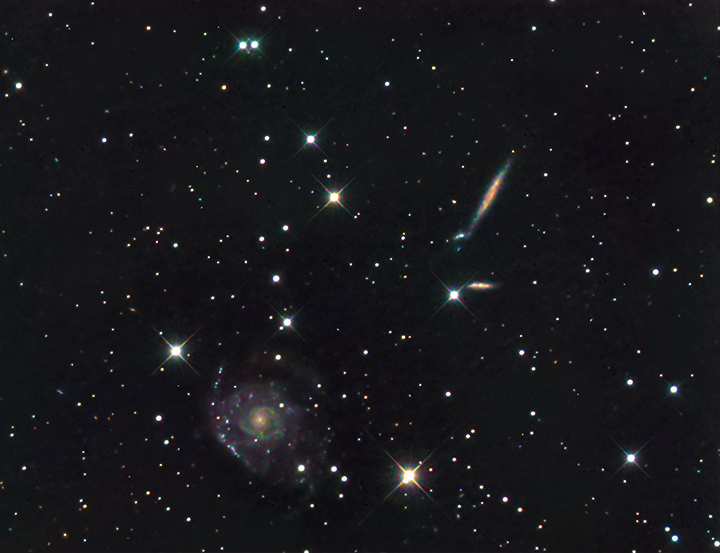
Same mono data as above, plus 24x300s RGB (2 hrs per channel)
I blame the moonlight.
3/16/2014. I baked the desiccant again. Might as well take advantage of the big ass moon while it's here. (Maybe after last night's showcase, Conrad called it a "big ice Moon" in honor of the season and the big, portentous halo, but "big ass moon" certainly fit.)
3/20/2014. Excited! I re-revisitted data from one cold night a couple of years ago and am 99% sure I got an esoteric target that I thought at the time I had missed. That's why you keep the raw data: by and by you learn better ways to handle it. So I want to be done with the NGC 2508 field and get back to that deep target in Leo. I devoted one more night with a smaller Moon and decent transparency to a good cut at NGC 2508.
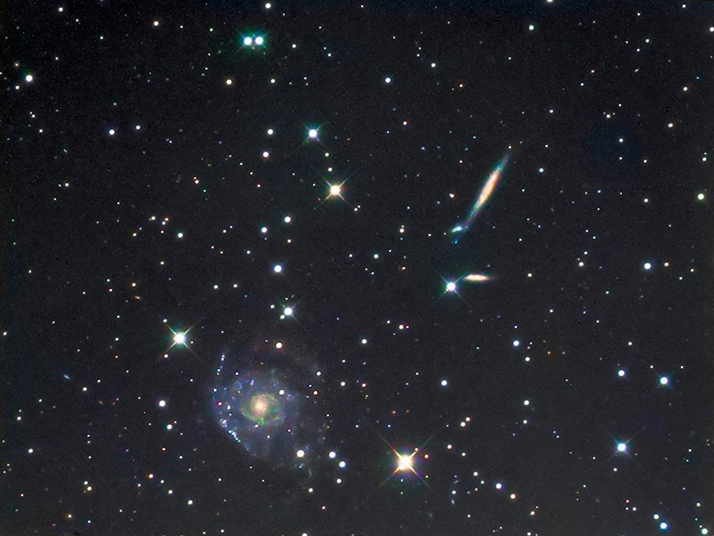
NGC 2508
best 35x300s L (2h 35m)
best 47x300s L (4h 35m)
24x300s RGB (2h per channel)
13h 10m total
3/21/2014. I'm ready to holler "uncle" on this one. I've spent most of the clear hours of March trying to get enough good L and RGB data to produce a decent image, and it just isn't coming along very well. It's not smooth, and it's not sharp. For once, I'm not convinced that more exposure is the answer. Something needs to be better -- focus, seeing, collimation, data reduction, something.
Miscellaneous preparations: After last night's imaging, I again lowered the chip temperature to -30°C and saw no signs of frost. I went to -35°C and held it for about ten minutes, and still saw none. I think this problem is solved. Rather than press on to -40°C and possible disappointment, I warmed the chip to -30°C and took some fresh darks before dawn.
I've been corresponding with another amateur who found my notes about collimating the AT10RC useful. He described a possible improvement involving two items: a white screen and a pinhole. Collimation has been much on my mind because the FWHM's I've been seeing are substantially larger than they were a couple of years ago. One night might be seeing, even two, but every one? I may be about to go on an adjustment tear. I really hate those. More when I know more.
I reset the focal position according to my notes about where the CCD comes to focus at the AT10RC's native focal length (2.5 cm on the focusing scale, plus a 2-inch extension tube). On to Leo.